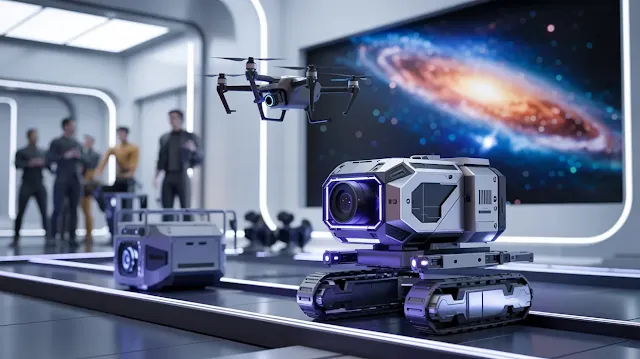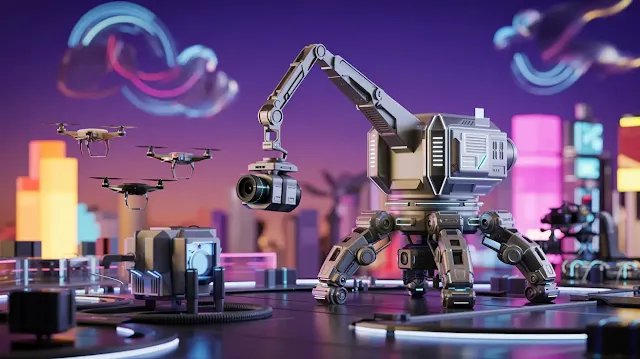How Robots and Drones Are Revolutionizing Modern Filmmaking
The Evolution of Cinematic Technology
Picture this: a filmmaker on set, gripping a remote control, orchestrating a drone that glides effortlessly through the sky, capturing breathtaking shots once considered impossible. Welcome to the new era of filmmaking, where cutting-edge technology, especially drones and robotic systems, is transforming the cinematic landscape.
The Rise of Drones in Cinematography
From Helicopters to Handheld Skies
Gone are the days when aerial shots required renting helicopters and expensive equipment. Today, drones offer a budget-friendly, highly efficient alternative that delivers cinematic views with unmatched clarity.
Precision Meets Creativity
Drones provide filmmakers with incredible flexibility and precision. Whether it’s a high-speed car chase or a sweeping landscape, drones allow for dynamic, fluid movement. Their ability to access tight, or elevated angles unlocks creative storytelling opportunities that were once unimaginable.
Robotic Systems Behind the Camera
More Than Sci-Fi Props
In addition to playing roles on screen, robots in filmmaking are essential tools behind the scenes. Robotic camera systems bring accuracy and consistency, enabling filmmakers to replicate complex shots flawlessly.
Capturing the Unseen
Specialized robotic arms are used for shooting intricate scenes like a single water droplet or high-speed motion. These tools bring microscopic detail into focus, enhancing the visual experience in extraordinary ways.
How Technology is Redefining Filmmaking
The Shift in Creative Process
Modern technology has revolutionized not just filmmaking tools, but also the mindset of filmmakers. With innovations like virtual reality (VR), creators can now construct entire immersive worlds that blend seamlessly with live-action footage.
Artificial Intelligence in Film Production
AI in filmmaking is making waves. From choosing optimal angles to assisting in editing and even directing, AI tools act as intelligent collaborators, streamlining production and enhancing creative decisions across every phase of filmmaking.
Creative Freedom Without Boundaries
The Magic of Drones and Robots Combined
Imagine a sequence where both drones and robotic cameras collaborate in harmony. The result? Cinematic artistry that feels alive, immersive, and emotionally resonant. These tools don’t just assist; they co-create.
From Tools to Creative Partners
Technology is no longer a passive asset, it’s an active partner in storytelling. With smart planning and execution, filmmakers can now bring their boldest visions to life.
Types of Robots Used in Filmmaking
Heavy-Duty Camera Robots
These robotic systems are built to carry heavy cameras for action-packed sequences, offering stability, strength, and precision during fast-paced scenes.
Compact Robotic Arms
Smaller robots excel in tight spaces or for capturing rapid movements. They are ideal for commercials, product shots, or artistic short films requiring agility and precision.
Robots in Special Effects and Animatronics
Many sci-fi creatures and fantasy monsters are created using robotic animatronics, giving lifelike motion to characters that were once possible only through CGI.
Changing Audience Expectations in the Digital Age
High-Tech Visuals as the New Norm
As technology advances, so do audience expectations. Viewers now anticipate visually rich experiences, driven by cutting-edge tools like drones and robots.
The Human Element Still Matters
However, technology alone doesn’t make a great film. Filmmakers must strike a balance, merging high-tech visuals with strong narratives. Ultimately, it’s the emotional connection that leaves a lasting impression.
What’s Next: The Future of Tech-Driven Filmmaking
Smarter Drones and AI-Driven Creativity
We are on the brink of a new era where AI-powered drones will analyze scripts, suggest ideal shot angles, and even make real-time adjustments based on lighting or actor positioning.
Robots as Creative Collaborators
Robotic tools may soon help write scripts, or analyze audience data to refine storytelling. As technology and storytelling converge, filmmakers will be able to push beyond traditional limits.
Conclusion: A New Chapter in Visual Storytelling
Robots and drones have forever changed the way stories are told on screen. These technologies offer directors powerful ways to enhance visuals, reduce costs, and push creative boundaries. They are not just filming tools, they are gateways to a more imaginative, immersive future.
Final Thoughts: Innovation or Intrusion?
As audiences and creators embrace this tech revolution, one question remains:
Are robots and drones enhancing cinematic art, or risking its soul?
We'd love to hear your perspective. Drop your thoughts in the comments below and join the conversation!




Write a comment, your opinion matters to us